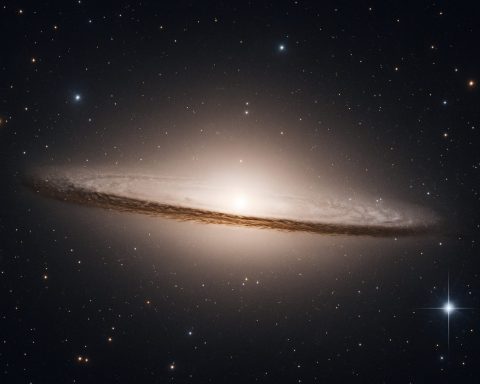- The cosmos has revealed a new puzzle: Odd Radio Circles (ORCs), challenging our understanding of the universe.
- Discovered in 2019 with the Australian Square Kilometer Array Pathfinder (ASKAP), ORCs are massive, circular radio emissions, visible only in radio wavelengths.
- Characterized by their spherical shape, ORCs evoke cosmic forces similar to gas expelled by dying stars but defy categorization.
- ORC 1 is tied to an elliptical galaxy possibly five billion light-years away, spanning two million light-years across.
- ORCs’ complexity increases with ORCs 2 and 3, whose close proximity suggests a shared origin or interaction.
- Theories propose ORCs may involve supermassive black holes or result from galaxy collisions.
- ORCs symbolize the universe’s remaining mysteries, inviting further exploration and discovery.
The cosmos, an ever-expanding expanse of mystery, has recently unveiled a new phenomenon that perplexes even the most seasoned astronomers. These peculiar objects—dubbed Odd Radio Circles (ORCs)—have emerged, challenging our understanding of the universe and sparking curiosity across the scientific community.
Nestled in the depths of space, the ORCs first came to light in 2019 during a pilot survey conducted with the then newly operational Australian Square Kilometer Array Pathfinder (ASKAP). This astonishing find stemmed from a collection of 36 radio dishes, casting their gaze into the heavens from Western Australia. What astronomers discovered defies conventional wisdom: massive, circular radio emissions without a known source, visible only in radio wavelengths.
Imagine standing in a field, gazing at soap bubbles that are ethereal yet discernible; these ORCs evoke a similar visual spectacle. Their spherical shape whispers of cosmic forces at play, akin to the winds of gas expelled by dying stars. Yet, the ORCs stubbornly refuse to fit any known category. Only through an astute blend of serendipity and advanced technology could such riddles be uncovered.
Take ORC 1, for instance. At its core lurks an elliptical galaxy some five billion light-years away, potentially the genesis of this spherical anomaly. If this distant galaxy indeed spawned ORC 1, this circular entity spans a mind-boggling two million light-years across, dwarfing our Milky Way. The scale is difficult to fathom, as if the cosmos itself is sketching on an infinite canvas. But there’s more ambiguity: The galaxy could just be a cosmic neighbor nudging our interpretation astray.
Other ORCs upend our understanding with even more complexity. ORCs 2 and 3 almost intertwine in the night sky, their proximity hinting at a shared origin or interaction. Yet their appearances differ starkly—a bright, ring-shaped enigma entangled with an ethereal, disk-like whisper of its counterpart. Common origin or mere coincidence? Both possibilities leave astronomers in awe.
In the years since this celestial revelation, more ORCs have emerged, and some contain galaxies at their centers, suggesting a deeper relationship with these cosmic giants. Theories postulate the involvement of supermassive black holes, whose fierce gravitational grip may forge these vast rings by spewing jets of matter into the intergalactic medium. An alternative narrative unfolds with the Cloverleaf ORC, whose hazy x-ray emission echoes the tumult of colliding galaxy groups and the energy that such collisions inject into the cosmos.
Astronomy has always thrived on the ability to interpret the unknown, systematizing chaos into comprehension. These enigmatic ORCs remind us that nature often defies simple explanation. Each ORC potentially narrates a distinct tale, from explosive stellar remnants to the orchestrated dance of galaxies. Disentangling these stories requires not only advanced technology but also relentless curiosity.
New discoveries linger on the horizon as our telescopes become more powerful, and each development promises to rewrite the chapters of cosmic history. For now, ORCs stand as luminous beacons of the unexplored, challenging us to rethink the universe and our place within it. The key takeaway is clear: The universe is still full of secrets, waiting for the intrepid and the inquisitive to uncover its wonders.
Unveiling the Mysteries of Odd Radio Circles: The Universe’s Latest Puzzle
What Are Odd Radio Circles?
Odd Radio Circles (ORCs) represent one of the most intriguing astronomical discoveries in recent years. Unveiled by researchers using the Australian Square Kilometer Array Pathfinder (ASKAP), these massive, circular radio emissions have left astronomers puzzled about their origins and implications.
The Cosmos Revealed
1. Discovery and Characteristics:
– ORCs were first spotted in 2019. These circular features are visible at radio wavelengths but are invisible in other spectra such as visible light or x-ray, suggesting unique physical conditions or processes at work.
2. Speculation on Origins:
– The leading hypotheses revolve around galaxies and supermassive black holes. Some theorize that ORCs could be the result of jets from black holes interacting with the interstellar medium or residues from merging galaxies, which could align with visible x-ray emissions.
3. Size and Structure:
– For perspective, ORC 1, one of the most prominent ORCs, possibly has a diameter spanning two million light-years, making it an enormous entity when compared to familiar galactic structures like the Milky Way.
Current Theories and Challenges
1. Black Holes and Galactic Activity:
– The interaction between supermassive black holes and surrounding material might create powerful jets that form ORCs. However, no direct link has been confirmed, and the exact mechanisms remain speculative.
2. Collision and Interaction:
– Some ORCs, such as the Cloverleaf ORC, show characteristics that could be linked to galaxy collisions. Astrophysical theories suggest that these collisions could inject enough energy into the surrounding space to form the ORCs.
3. Distinct Origins:
– Each ORC might have a unique cause or process leading to its formation, a hypothesis that requires more detailed observations and theoretical modeling. The diversity in appearance among different ORCs suggests multiple formation paths.
Real-World Use Cases and Technological Implications
1. Technological Advancements:
– Discovering ORCs underscores the importance of advanced radio astronomy techniques and facilities like ASKAP. These infrastructures not only help catalog such phenomena but also play a crucial role in examining the universe’s earliest stages.
2. Educational Influence:
– ORCs provide an excellent opportunity for educational programs, sparking curiosity and driving young scientists to explore astronomy and related fields.
Future Prospects and Predictions
1. Enhanced Observational Strategies:
– As telescopes like the Square Kilometer Array become operational, their increased sensitivity and range could offer more insights, potentially even observing the birth or lifecycle of an ORC.
2. Refining Theoretical Models:
– As more data becomes available, theoretical physicists and astronomers will refine existing models to better comprehend ORCs’ formation and implications, contributing to broader cosmic knowledge.
Actionable Recommendations and Quick Tips
1. Staying Informed:
– Keep an eye on publications from observatories and space agencies, as ORC research is evolving rapidly. Subscribe to astronomy journals or follow updates from prominent institutions like the Nasa.
2. Engaging with the Science Community:
– Join online forums or local astronomy clubs to engage in discussions and share insights about ongoing research and discoveries surrounding ORCs.
3. Educational Resources:
– Utilize platforms like Space or the European Southern Observatory for educational articles, updates, and resources that delve deeper into topics like ORCs and other cosmic phenomena.
By immersing in the enigmatic world of Odd Radio Circles, we not only delve into one of the universe’s most recent puzzles but also embrace the adventure of exploring unknown cosmic realms.










